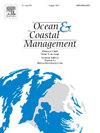尼日利亚尼日尔三角洲查诺米河附近底栖大型无脊椎动物的水化学生态风险评价
IF 4.8
2区 环境科学与生态学
Q1 OCEANOGRAPHY
引用次数: 0
摘要
水污染和不受管制的人类活动对底栖大型无脊椎动物及其生态作用构成全球性风险。本研究将重金属污染指数与BMI生物监测相结合,建立了尼日尔三角洲Chanomi Creek水化学污染的生态风险评价方法,为研究水生态系统退化的时空动态提供了新的思路。在2020年3月至2021年8月期间,使用Hydrobios水采样器和Van-Veen Grab每月采集10个站点的水和底栖生物样本。电导率、总悬浮固体(TSS)、溶解氧(DO)、总溶解固体(TDS)、硫酸盐、浊度和HMs均超过规定限制。生物需氧量和DO在旱季升高,TDS、电导率和浊度在旱季升高。废物处理、非法炼油和原油开采加剧了浑浊和化学污染,尤其是在旱季。重金属污染指数(2564.44 ~ 4693.33)和评价指数(113.2 ~ 289.6)表现为重度污染,以Cu和Cr为主,旱季污染尤为严重。PCA鉴定了浑浊和过多固体主导的PC1(32.46%方差),而PC2(16.86%方差)反映了营养物质和HMs污染。底栖动物群落以软体动物为主(77.5%),其中以褐鼓膜动物为主(32.5%),对中度污染表现出适应力,对重度污染表现出脆弱性。nMDS和CCA将BMI分布与水质联系起来,高金属负荷降低了多样性。Mytilus edulius、Cassostrea gazar和Arenicola marina表明水质较差,而f var.radula、Pachymelania aurita和T. fuscatus表明生态系统受到干扰,但具有生物功能。这些发现支持监管框架、生态系统保护和可持续水资源管理。本文章由计算机程序翻译,如有差异,请以英文原文为准。

Ecological risk assessment of the hydrochemistry for benthic macroinvertebrates adjoining Chanomi Creek, Niger Delta, Nigeria
Water pollution and unregulated human activities pose global risks to benthic macroinvertebrates (BMIs) and their ecological roles. This study provides a novel ecological risk assessment of hydrochemical contamination in Chanomi Creek, Niger Delta, by integrating heavy metal (HM) pollution indices with BMI biomonitoring, offering new insights into the spatiotemporal dynamics of aquatic ecosystem degradation. Water and benthic samples were collected monthly from 10 stations (March 2020–August 2021) using a Hydrobios water sampler and Van-Veen Grab. Conductivity, total suspended solids (TSS), dissolved oxygen (DO), total dissolved solids (TDS), sulphate, turbidity, and HMs exceeded regulatory limits. Biological oxygen demand and DO were elevated in the wet season, while TDS, conductivity, and turbidity increased in the dry season. Waste disposal, illegal refining, and crude oil extraction intensified turbidity and chemical pollution, especially in the dry season. Heavy Metal Pollution Index (2564.44–4693.33) and Evaluation Index (113.2–289.6) revealed extreme contamination, mainly from Cu and Cr, especially in the dry season. PCA identified turbid and excessive solids-dominated PC1 (32.46 % variance), while PC2 (16.86 %) reflected nutrient and HMs contamination. Molluscs (77.5 %), mainly Tympanotonus fuscatus (32.5 %), dominated the benthic community, exhibiting resilience to moderate pollution but vulnerability to severe contamination. nMDS and CCA linked BMI distribution to water quality, with high metal loads reducing diversity. Mytilus edulius, Cassostrea gazar, and Arenicola marina indicated poor water quality, while Tf var.radula, Pachymelania aurita, and T. fuscatus indicated disturbed but biologically functional ecosystems. These findings support regulatory frameworks, ecosystem conservation, and sustainable water resource management.
求助全文
通过发布文献求助,成功后即可免费获取论文全文。
去求助
来源期刊

Ocean & Coastal Management
环境科学-海洋学
CiteScore
8.50
自引率
15.20%
发文量
321
审稿时长
60 days
期刊介绍:
Ocean & Coastal Management is the leading international journal dedicated to the study of all aspects of ocean and coastal management from the global to local levels.
We publish rigorously peer-reviewed manuscripts from all disciplines, and inter-/trans-disciplinary and co-designed research, but all submissions must make clear the relevance to management and/or governance issues relevant to the sustainable development and conservation of oceans and coasts.
Comparative studies (from sub-national to trans-national cases, and other management / policy arenas) are encouraged, as are studies that critically assess current management practices and governance approaches. Submissions involving robust analysis, development of theory, and improvement of management practice are especially welcome.
 求助内容:
求助内容: 应助结果提醒方式:
应助结果提醒方式:


